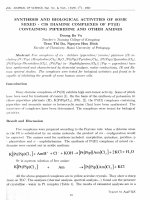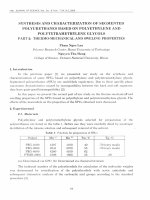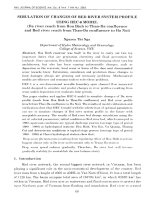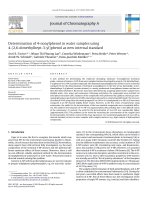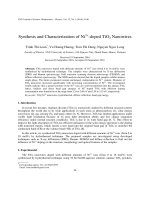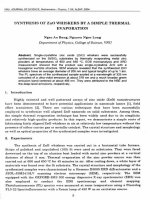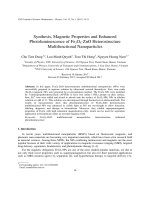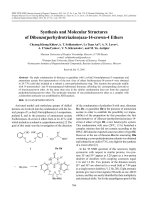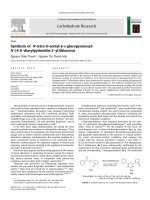DSpace at VNU: Synthesis of N-tetra-O-acetyl-beta-D-glucopyranosyl-N '-(4 ',6 '-diarylpyrimidin-2 '-yl)thioureas
Bạn đang xem bản rút gọn của tài liệu. Xem và tải ngay bản đầy đủ của tài liệu tại đây (247.44 KB, 7 trang )
Carbohydrate Research 344 (2009) 2399–2405
Contents lists available at ScienceDirect
Carbohydrate Research
journal homepage: www.elsevier.com/locate/carres
Note
Synthesis of N-tetra-O-acetyl-b-D-glucopyranosylN0 -(40 ,60 -diarylpyrimidin-20 -yl)thioureas
Nguyen Dinh Thanh *, Nguyen Thi Thanh Mai
Faculty of Chemistry, College of Science, Hanoi National University, 19 Le Thanh Tong, Hanoi 10000, Viet Nam
a r t i c l e
i n f o
Article history:
Received 20 June 2009
Received in revised form 30 August 2009
Accepted 1 September 2009
Available online 6 September 2009
Keywords:
Pyrimidine
Glucopyranosyl thiourea
Glucopyranosyl isothiocyanate
Microwave-assisted method
a b s t r a c t
Some 2-amino-4,6-diarylpyrimidines 2 have been prepared from substituted benzylideneacetophenones
and guanidine hydrochloride in the presence of alkali by conventional heating in alcoholic medium and
microwave heating in solvent-free conditions. N-(2,3,4,6-Tetra-O-acetyl-b-D-glucopyranosyl)-N0 -(40 ,60 diarylpyrimidin-20 -yl)thioureas 4 have been synthesized by reaction of per-O-acetylated glucopyranosyl
isothiocyanate 1 and substituted 2-amino-4,6-diarylpyrimidines 2. Two different methods have been
used, namely, refluxing in anhydrous dioxane and solvent-free microwave-assisted coupling. The second
procedure afforded higher yields in much shorter reaction times. The compounds 2 and 4 were tested for
their antibacterial and antifungal activities in vitro against Staphylococcus epidermidis, Enterobacter
aerogenes and Candida albicans by disc diffusion method.
Ó 2009 Elsevier Ltd. All rights reserved.
The pyrimidine structural motif is a fundamental part of nucleic
acids and has been associated with a number of biological activities.1,2 Aminopyrimidine derivatives have displayed interesting
antibacterial, antitumour and HIV-I inhibiting activities.2 Both
pyrimidine and aminopyrimidine moieties occur in commercially
available drugs such as the anti-atherosclerotic AronixilÒ, the antihistaminic ThonzylamineÒ, the anti-anxiolytic BuspironeÒ, and in
other medicinally relevant compounds as well.3
In an other hand, sugar isothiocyanates are among the most
versatile synthetic intermediates in carbohydrate chemistry.4 They
play a pivotal role in the preparation of a broad series of functional
groups such as amide, isonitrile, carbodiimide and N-thiocarbonyl
derivatives allowing, simultaneously, the covalent coupling of a
quite unrestricted variety of structures to the saccharide part.5
Moreover, isothiocyanates are important reagents in heterocyclic
chemistry, which may be exploited in the synthesis of nucleosides
and other N-glycosyl structures.6,7
One of the most popular and interesting approach in the context
of ‘green chemistry’ is employing microwave energy for conducting chemical transformations, which allows a higher speed of heating, shorter reaction times, is compatible with solvent-free
conditions and very often lead to higher selectivities.8–11
Thioureas and derivatives are biologically important compounds and are useful fungicides, herbicides12 and antibacterial
agents.13 They have also found use in organocatalysis.14,15 Thioureas have been synthesized by the reaction of primary and secondary amines with thiophosgene and isothiocyanates.4,5,16–19
Glucopyranosyl thioureas containing heterocycles (such as thiazole, benzothiazole20 and thiadiazole21) were synthesized using
conventional heating method. We report herein the preparation
of some peracetylated glucopyranosyl thioureas containing the
pyrimidine nucleus both under classical heating and solvent-free
microwave irradiation conditions.
2-Aminopyrimidines were prepared previously by the reaction of substituted benzylideneacetophenones22 with guanidine
under reflux in ethanol.3,23 For the purpose of this work, we
have prepared new 2-amino-4,6-diarylpyrimidines 2a–j by ringclosure condensation of substituted benzylideneacetophenones
and guanidine hydrochloride in the presence of sodium hydroxide under microwave-assisted conditions and compare the
results with the classical procedures (Scheme 1 and Table 1).
N-(2,3,4,6-Tetra-O-acetyl-b-D-glucopyranosyl)-N0 -(40 ,60 -diarylpyrimidin-20 -yl)thioureas 4a–j were subsequently synthesized by the
condensation of tetra-O-acetyl-b-D-glucopyranosyl isothiocyanate
and the corresponding 2-aminopyrimidines 2a–j. We performed
O
NH2C(=NH)NH2.HCl
R
1a-j
Home MW oven
N
N
R
NH2
2a-j
1a-j and 2a-j: R= H (a), p-F (b), p-Cl (c), m-Cl (d), p-Br (e),
p -Me (f), p-iPr (g), o -OH (h), p -OMe (i), m-OMe (j)
* Corresponding author. Tel.: +84 4 8261853; fax: +84 4 8241140.
E-mail address: (N.D. Thanh).
0008-6215/$ - see front matter Ó 2009 Elsevier Ltd. All rights reserved.
doi:10.1016/j.carres.2009.09.002
Scheme 1. Synthetic pathway for 2-amino-4,6-diarylpyrimidines (2a–j).
2400
N. D. Thanh, N. T. T. Mai / Carbohydrate Research 344 (2009) 2399–2405
Table 1
2-Amino-4,6-diarylpyrimidines (2a–j)
Entry
R
2a
2b
2c
2d
2e
2f
2g
2h
2i
2j
H
p-F
p-Cl
m-Cl
p-Br
p-Me
p-iPr
o-OH
p-OMe
m-OMe
Yield (%)
A
B
72
—
76
75
71
—
—
70
73
—
89
86
85
83
80
85
85
85
80
83
Microwave irradiation time (min)
1
2
2
2
2
1
1
1
1
1
A: by refluxing; B: under solvent-free condition in modified domestic microwave
oven.
this reaction by using two methods: by refluxing in anhydrous
dioxane for 8–10 h and by irradiation in a domestic microwave
oven for a few minutes in solvent-free condition (Scheme 2
and Table 2). The last method accelerated the reactions and gave
higher yields.
We realized that 2-amino-4,6-diphenylpyrimidines with electron-withdrawing group (such NO2, except halogens) cannot be
formed; we tried to perform the reaction of benzylideneacetophenones having nitro-group with guanidine, but the reactions were
unsuccessful.
In the refluxing cases, 2-aminopyrimidines 2 and peracetylated
glucopyranosyl isothiocyanate 3 were dissolved in anhydrous
dioxane. After the reaction, the solvent was distilled off, and the
resultant sticky residue was triturated with ethanol to afford thioureas 4a–j that were recrystallized with 1:1 ethanol–toluene.
Using MW irradiation, a mixture of 2-aminopyrimidine and peracetylated glucopyranosyl isothiocyanate was grinded together
and irradiated in domestic MW oven (750 W). After first several
minutes of microwave irradiation (MWI), the reaction mixture
became pastry. The reaction yields increased using MW oven from
60–68% to 68–80%. All the obtained thioureas were soluble in common organic solvents (such as ethanol, methanol, toluene, benzene
and DMF). Their structures have been confirmed by spectral (IR,
NMR and MS) data.
The IR spectra showed characteristic bands at 3522–3410 (mNH),
1754–1748 (mC@O), 1594, 1578, 1526, 1495 (mC@C), 1364–1362
(mC@S), 1232–1222 and 1070–1041 cmÀ1 (mCOC). The 1H NMR spectra showed resonance signals which are specific for protons in
thiourea-NH groups at d = 11.16–12.04 ppm. Proton H-1 has its
chemical shift at d = 6.19–6.21 ppm (in triplet) with couple constants J12 = 9.0–9.5 Hz. The resonance signal of H-2 appeared as a
triplet at d = 5.02–5.06 ppm with J12 = 9.0–9.5 Hz. The coupling
constant values for the pyranose ring agreed with trans-axial H–
H disposition and a b-anomeric configuration. The 13C NMR spectra
showed signals for the thiocarbonyl group at d = 181.3–
181.4 ppm.24 The mass spectra showed M+ peak at the respective
molecular weights of the compounds. Some of them were subjected to HREIMS to obtain respective molecular weights.
Compounds 2 and 4 were screened for their antibacterial and
antifungal activities in vitro against Staphylococcus epidermidis,
Enterobacter aerogenes and Candida albicans by the disc diffusion
method. All amines 2 have significant biological activities against
E. aerogenes, S. epidermidis and C. albicans. Compounds 2a–j
showed highest antibacterial activity against S. Epidermidis (Table
3). Almost all compounds 4 have remarkable biological activity, except compound 4b which exhibited no antifungal activity against
E. aerogenes and compound 4g against C. albicans. Especially, the
antibacterial activity against S. epidermidis was proved significantly
in these compounds (Table 4).
In summary, the present new method of formation of 2amino-4,6-diarylpyrimidines 2 and N-(2,3,4,6-tetra-O-acetyl-b-Dglucopyranosyl)-N0 -(40 ,60 -diarylpyrimidin-20 -yl)thioureas 4 under
microwave irradiation offers several advantages: faster reaction
rates (1–2 min for 2 and 5–7 min for 4) and high yields (80–89%
for 2 and 72–83% for 4), while the conventional method of formation of these thioureas involves longer reaction times (8–10 h and
60–68% for 4).
1. Experimental
1.1. General methods
Melting points were determined on a STUART SMP3 apparatus
(BIBBY STERILIN-UK). The FTIR-spectra were recorded on a Magna
Table 2
N-(2,3,4,6-Tetra-O-acetyl-b-D-glucopyranosyl)-N’-(4,6-diarylpyrimidin-2-yl)thioureas
(4a–j)
a
b
Entry
R
Yielda
(%)
Refluxing
time (h)
Yieldb
(%)
Microwave
irradiation
time (min)
4a
4b
4c
4d
4e
4f
4g
4h
4i
4j
H
p-F
p-Cl
m-Cl
p-Br
p-Me
p-iPr
o-OH
p-OMe
m-OMe
60
—
68
67
66
60
68
60
68
—
8
—
9
10
9
8
8
9
8
—
75
87
76
72
76
80
79
80
77
83
5
5
6
7
5
7
6
6
6
6
By refluxing.
By using microwave oven.
OAc
OAc
O
AcO
AcO
OAc
NCS
+
2a-j
i or ii
3
AcO
AcO
R
O
OAc
a
NH
b N
NH
N
S
4a-j
2a-j and 4a-j: R= H (a), p-F (b), p-Cl (c), m-Cl (d), p-Br (e),
p -Me (f), p-iPr (g), o-OH (h), p-OMe (i), m-OMe (j)
i: anhydrous dioxane, reflux 8-10 h
ii: solvent-free, MW irradiation 5-7 min
Scheme 2. Synthetic pathway for N-(2,3,4,6-tetra-O-acetyl-b-D-glucopyranosyl)-N0 -(4,6-diarylpyrimidin-2-yl)thioureas (4a–j).
N. D. Thanh, N. T. T. Mai / Carbohydrate Research 344 (2009) 2399–2405
Table 3
Response of various micro-organisms to substituted amino-4,6-diarylpyrimidine 2a–j
Entry
2a
2b
2c
2d
2e
2f
2g
2h
2i
2j
Ref.
E. aerogenes
S. epidermidis
C. albicans
15
26
20
18
15
23
22
18
18
19
25b
30
30
29
30
28
27
26
23
29
25
25c
20
25
17
20
15
26
25
24
18
22
35d
Ref = b ampicillin; c methicillin; d clotrimazole.
a
DMF used as control; concentration used = 100 lg/mL of DMF.
Table 4
Response of various micro-organisms to substituted N-(2,3,4,6-tetra-O-acetyl-b-Dglucopyranosyl)-N’-(40 ,60 -diarylpyrimidin-20 -yl)thioureas 4a–j
Entry
R
4a
4b
4c
4d
4e
4f
4g
4h
4i
4j
Ref.
H
p-F
p-Cl
m-Cl
p-Br
p-Me
p-iPr
o-OH
p-OMe
m-OMe
—
1.2. General procedure for the synthesis of 2-amino-4,6diarylpyrimidines (2a–j)
Diameter of zone inhibitiona (mm)
R
H
p-F
p-Cl
m-Cl
p-Br
p-Me
p-iPr
o-OH
p-OMe
m-OMe
—
2401
Diameter of zone inhibition (mm)a
E. aerogenes
S. epidermidis
C. albicans
15
17
0
13
18
20
22
20
23
22
35b
27
28
30
28
30
28
29
27
29
24
35c
15
16
14
19
21
20
22
21
0
22
45d
Ref = b ampicillin; c methicillin; d clotrimazole.
a
DMF used as control; concentration used = 100 lg/mL of DMF.
760 FT-IR Spectrometer (NICOLET, USA) in KBr pellets. The 1H NMR
(500.13 MHz) and 13C NMR (125.77 MHz) spectra were recorded
on an AVANCE500 Spectrometer (BRUKER, Germany) in DMSO-d6
solution; d are in ppm compared to TMS as internal reference at
300 K. The assignments of 1H and 13C were confirmed using HMBC
and HSQC methods. The high-resolution mass spectra were recorded on AutoSpec Premier instrument (WATERS, USA) using EI.
Optical rotations were measured on a POLAX-2L polarimeter
(ATAGO-Japan) in DMSO solution. Analytical thin-layer chromatography (TLC) was performed on Silica Gel 60F254 No. 5715
(Merck, Germany) with EtOAc and light petroleum (bp 60–90 °C).
The spots were visualized by exposure to UV light or by spraying
the plates with 10% (v/v) H2SO4 in EtOH, followed by heating.
2,3,4,6-Tetra-O-acetyl-b-D-glucopyranosyl isothiocyanate 3 was
prepared by the reaction of per-O-acetylated-b-D-glucopyranosyl
bromide25 with lead thiocyanate in dried toluene.20 Other reagents
were supplied by Merck and used as received.
In order to perform the reaction in a domestic microwave oven,
we have built a modified commercial microwave oven (Tiffany
MM17L, power 750 W) in which the round-bottomed flask was attached to a condenser. This condenser was assembled with the
flask in microwave oven through a hole on the top. The condenser
was protected with a metallic wire mesh connected to the oven
body to avoid any microwave leakages. It is also possible to conduct the experiments under controlled atmosphere like nitrogen
(Fig. 1, see in Supplementary data).
Procedure A (under refluxing condition). A solution of substituted
benzylideneacetophenone 1 (10 mmol) in ethanol (5 mL) was
added to a solution of guanidine hydrochloride (15 mmol) and sodium hydroxide (45 mmol) in water (2 mL). The reaction mixture
was refluxed for 10 min in the modified domestic microwave oven.
The solvent was removed under reduced pressure and the residue
was triturated with water and the precipitate was filtered by
suction and washed with water until neutral to afford the title
compounds 2, which were recrystallized from 1:1 EtOH-toluene
to give ivory-white crystals.
Procedure B (under microwave-assisted and solvent-free
conditions). Substituted benzylideneacetophenone 1 (10 mmol),
guanidine hydrochloride (15 mmol) and sodium hydroxide
(45 mmol) were mixed carefully with a little water. The obtained
mixture was irradiated under domestic microwave oven. After
1–2 min, the reaction mixture had become dark-yellow, and then
the irradiation was continued for the given time. Upon
completion, monitored by TLC, the reaction mixture was cooled
to room temperature and then triturated with water and the
formed precipitate was filtered by suction and washed
with water until neutral to afford the title compounds 2, which
were recrystallized from 1:1 EtOH-toluene to give ivory-white
crystals.
1.2.1. 2-Amino-4,6-diphenylpyrimidine (2a)
From benzylideneacetophenone (2.08 g, 10 mmol) and guanidine hydrochloride (1.43 g, 15 mmol). Recrystallized from EtOH/
toluene to yield a white solid, 1.78 g, 72% (procedure A); 2.20 g,
89% (procedure B); mp 118–119 °C; IR (KBr) m/cmÀ1: 3469, 3320,
1601; 1H NMR (DMSO-d6): d 8.22–8.20 (m, 4H, H-30 & H50 and H300 & H-500 ), 7.70 (s, 1H, H-5), 7.53–7.52 (m, 6H, H-20 , H-40 & H-60
and H-200 , H-400 & H-600 ); HREIMS: calcd for C16H13N3: 247.1109,
found: 247.0929. Anal. Calcd for C16H12BrN3: C, 77.71; H, 5.30; N,
16.99. Found: 77.86; H, 5.46; N, 17.05.
1.2.2. 2-Amino-4-(p-fluorophenyl)-6-phenylpyrimidine (2b)
From p-fluorobenzylideneacetophenone (2.26 g, 10 mmol) and
guanidine hydrochloride (1.43 g, 15 mmol). Recrystallized from
EtOH/toluene to yield a white solid, 2.78 g, 86% (procedure B);
mp 132–133 °C; IR (KBr) m/cmÀ1: 3493, 3314, 1634; 1H NMR
(DMSO-d6): d 8.30 (s, 1H, H-20 ), 8.25–8.23 (m, 2H, H-300 & H-500 ),
8.20 (d, 1H, J = 7.5 Hz, H-40 ), 7.78 (s, 1H, H-5), 7.59–7.75 (m, 2H,
J = 7.5 Hz & 3.0 Hz, H-50 & H60 ), 7.53–7.52 (m, 3H, H-200 , H-400 &
H-600 ), 6.80 (s, 2H, NH2). Anal. Calcd for C16H12FN3: C, 72.44; H,
4.56; N, 15.84. Found: C, 72.60; H, 4.60; N, 15.80.
1.2.3. 2-Amino-4-(p-chlorophenyl)-6-phenylpyrimidine (2c)
From p-chlorobenzylideneacetophenone (2.42 g, 10 mmol) and
guanidine hydrochloride (1.43 g, 15 mmol). Recrystallized from
EtOH/toluene to yield a white solid, 2.14 g, 76% (procedure A);
2.25 g, 85% (procedure B); mp 160–161 °C; IR (KBr) m/cmÀ1:
3493, 3314, 1634; 1H NMR (DMSO-d6): d 8.30 (s, 1H, H-20 ), 8.25–
8.23 (m, 2H, H-300 & H-500 ), 8.20 (d, 1H, J = 7.5 Hz, H-40 ), 7.78
(s, 1H, H-5), 7.59–7.75 (m, 2H, J = 7.5 Hz & 3.0 Hz, H-50 & H60 ),
7.53–7.52 (m, 3H, H-200 , H-400 & H-600 ), 6.80 (s, 2H, NH2); HREIMS
calcd for C16H1235ClN3/C16H1237ClN3: 281.0719/283.0690, found:
281.0796/283.0660. Anal. Calcd for C16H12ClN3: C, 68.21; H, 4.29;
N, 14.91. Found: C, 68.45; H, 4.31; N, 14.84.
1.2.4. 2-Amino-4-(m-chlorophenyl)-6-phenylpyrimidine (2d)
From m-chlorobenzylideneacetophenone (2.42 g, 10 mmol) and
guanidine hydrochloride (1.43 g, 15 mmol). Recrystallized from
EtOH/toluene to yield a white solid, 2.11 g, 75% (procedure A);
2402
N. D. Thanh, N. T. T. Mai / Carbohydrate Research 344 (2009) 2399–2405
2.34 g, 83% (procedure B); mp 118–119 °C; IR (KBr) m/cmÀ1: 3491,
3315, 1634; 1H NMR (DMSO-d6): d 8.30 (s, 1H, H-20 ), 8.25–8.23 (m,
2H, H-300 & H-500 ), 8.20 (d, 1H, J = 7.5 Hz, H-40 ), 7.78 (s, 1H, H-5),
7.59–7.75 (m, 2H, J = 7.5 Hz & 3.0 Hz, H-50 & H60 ), 7.53–7.52 (m,
3H, H-200 , H-400 & H-600 ), 6.80 (s, 2H, NH2); HREIMS calcd for
C16H1235ClN3/C16H1237ClN3: 281.0719/283.0690, found: 281.0724/
283.0745. Anal. Calcd for C16H12ClN3: C, 68.21; H, 4.29; N, 14.91.
Found: C, 68.55; H, 4.38; N, 14.87.
1.2.5. 2-Amino-4-(p-bromophenyl)-6-phenylpyrimidine (2e)
From p-bromobenzylideneacetophenone (2.87 g, 10 mmol) and
guanidine hydrochloride (1.43 g, 15 mmol). Recrystallized from
EtOH/toluene to yield a white solid, 2.31 g, 71% (procedure A);
2.61 g, 80% (procedure B); mp 171–172 °C; IR (KBr) m/cmÀ1:
3493, 3294, 3159, 1632; 1H NMR (DMSO-d6): d 8.22–8.20 (m, 2H,
H-300 & H-500 ), 8.18 (d, 2H, J = 8.5 Hz, H-30 & H50 ), 7.72 (s, 1H, H5), 7.72 (d, 2H, J = 8.5 Hz, H-20 & H60 ), 7.53–7.51 (m, 3H,
J = 3.5 Hz, H-200 , H-400 & H-600 ), 6.76 (s, 2H, NH2); HREIMS calcd for
C16H1279BrN3/C16H1281BrN3: 325.0215/327.0194, found: 325.3736/
327.3077. Anal. Calcd for C16H12BrN3: C, 58.91; H, 3.71; N, 12.88.
Found C, 59.11; H, 3.61; N, 12.85.
1.2.6. 2-Amino-4-(p-methylphenyl)-6-phenylpyrimidine (2f)
From p-methylbenzylideneacetophenone (2.22 g, 10 mmol) and
guanidine hydrochloride (1.43 g, 15 mmol). Recrystallized from
EtOH/toluene to yield a white solid, 2.22 g, 85% (procedure B);
mp 127–128 °C; IR (KBr) m/cmÀ1: 3363, 3327, 3191, 1642; 1H
NMR (DMSO-d6): d 8.20–8.18 (m, 2H, H-300 & H-500 ), 8.19 (d, 2H,
J = 9.0 Hz, H-30 & H50 ), 7.64 (s, 1H, H-5), 7.52–7.50 (m, 3H, H-200 ,
H-400 & H-600 ), 7.06 (d, 2H, J = 9.0 Hz, H-20 & H60 ), 6.61 (s, 2H,
NH2), 2.41 (s, 3H, CH3); Anal. Calcd for C17H15N3: C, 78.13; H,
5.79; N, 16.08. Found: C, 73.20; H, 5.30; N, 15.41.
1.2.7. 2-Amino-4-(p-isopropylphenyl)-6-phenylpyrimidine (2g)
From p-isopropylbenzylideneacetophenone (2.50 g, 10 mmol)
and guanidine hydrochloride (1.43 g, 15 mmol). Recrystallized
from EtOH/toluene to yield a white solid, 2.46 g, 85% (procedure
B); mp 141–142 °C; IR (KBr) m/cmÀ1: 3363, 3327, 3191, 1642; 1H
NMR (DMSO-d6): d 8.20–8.18 (m, 2H, H-300 & H-500 ), 8.19 (d, 2H,
J = 9.0 Hz, H-30 & H50 ), 7.64 (s, 1H, H-5), 7.52–7.50 (m, 3H, H-200 ,
H-400 & H-600 ), 7.06 (d, 2H, J = 9.0 Hz, H-20 & H60 ), 6.61 (s, 2H,
NH2), 3.02 [septet, 1H, J = 12.0 Hz, 4000 -CH(CH3)2], 1.28 [d, 6H,
J = 12.0 Hz, 4000 -CH(CH3)2]; Anal. Calcd for C19H19N3: C, 78.86; H,
6.62; N, 14.52. Found: C, 78.74; H, 6.42; N, 14.72.
1.2.8. 2-Amino-4-(o-hydroxyphenyl)-6-phenylpyrimidine (2h)
From o-hydroxybenzylideneacetophenone (2.24 g, 10 mmol)
and guanidine hydrochloride (1.43 g, 15 mmol). Recrystallized
from EtOH/toluene to yield a white solid, 1.84 g, 70%, procedure
A; 2.24 g, 85% (procedure B); mp 181–182 °C; IR (KBr) m/cmÀ1:
3519, 3362, 3204, 1629; 1H NMR (DMSO-d6): d 8.25–8.21 (m, 3H,
H-300 , H-500 & H-30 ), 7.86 (s, 1H, H-5), 7.54–7.53 (m, 3H, H-200 , H400 & H-600 ), 7.37–7.34 (td, 1H, J = 8.5 Hz & 1.25 Hz, H-60 ), 7.18 (br,
OH & NH2), 6.90 (t, 1H, J = 7.0 Hz, H-50 ), 6.90 (dd, 1H, J = 8.5 Hz &
1.25 Hz, H-40 ); HREIMS calcd for C16H13N3O: 263.1059, found:
263.0977. Anal. Calcd for C16H13N3O: C, 72.99; H, 4.98; N, 15.96.
Found: C, 72.69; H, 4.88; N, 15.67.
1.2.9. 2-Amino-4-(p-methoxyphenyl)-6-phenylpyrimidine (2i)
From p-methoxybenzylideneacetophenone (2.38 g, 10 mmol)
and guanidine hydrochloride (1.43 g, 15 mmol). Recrystallized
from EtOH/toluene to yield a white solid, 2.02 g, 73% (procedure
A); 2.22 g, 80% (procedure B); mp 151–152 °C; IR (KBr) m/cmÀ1:
3363, 3327, 3191, 1642; 1H NMR (DMSO-d6): d 8.20–8.18 (m, 2H,
H-300 & H-500 ), 8.19 (d, 2H, J = 9.0 Hz, H-30 & H50 ), 7.64 (s, 1H, H5), 7.52–7.50 (m, 3H, H-200 , H-400 & H-600 ), 7.06 (d, 2H, J = 9.0 Hz,
H-20 & H60 ), 6.61 (s, 2H, NH2), 3.84 (s, 3H, OCH3); HREIMS calcd
for C17H15N3O: 277.1215, found: 277.0977. Anal. Calcd for
C17H15N3O: C, 73.63; H, 5.45; N, 15.15. Found: C, 73.83; H, 5.35;
N, 15.35.
1.2.10. 2-Amino-4-(m-methoxyphenyl)-6-phenylpyrimidine
(2j)
From m-methoxybenzylideneacetophenone (2.38 g, 10 mmol)
and guanidine hydrochloride (1.43 g, 15 mmol). Recrystallized
from EtOH/toluene to yield a white solid, 2.29 g, 83% (procedure
B); mp 139–140 °C; (KBr) m/cmÀ1: 3491, 3315, 1634; 1H NMR
(DMSO-d6): d 8.30 (s, 1H, H-20 ), 8.25–8.23 (m, 2H, H-300 & H-500 ),
8.20 (d, 1H, J = 7.5 Hz, H-40 ), 7.78 (s, 1H, H-5), 7.59–7.75 (m, 2H,
J = 7.5 Hz & 3.0 Hz, H-50 & H60 ), 7.53–7.52 (m, 3H, H-200 , H-400 &
H-600 ), 6.80 (s, 2H, NH2), 3.92 (s, 3H, OCH3); Anal. Calcd for
C17H15N3O: C, 73.63; H, 5.45; N, 15.15. Found: C, 73.80; H, 5.31;
N, 15.39.
1.3. General procedure for the synthesis of N-(2,3,4,6-tetra-Oacetyl-b-D-glucopyranosyl)-N0 -(40 ,60 -diarylpyrimidin-20 yl)thioureas (4a–j)
Procedure A (under refluxing condition). A solution of 2-amino4,6-diarylpyrimidine 2 (2 mmol) in anhydrous dioxane (10 mL)
was added to a solution of 2,3,4,6-tetra-O-acetyl-b-D-glucopyranosyl isothiocyanate 3 (2 mmol) in anhydrous dioxane (10 mL). The
reaction mixture was heated at reflux for 8–10 h. Then the solvent
was removed under reduced pressure, and the residue was triturated with ethanol. The precipitate was filtered by suction and
recrystallized with 1:1 EtOH-water to afford the title compounds
4 as ivory-white crystals.
Procedure B (under microwave-assisted and solvent-free conditions). A mixture of 2-amino-4,6-diarylpyrimidine 2 (2 mmol)
and 2,3,4,6-tetra-O-acetyl-b-D-glucopyranosyl isothiocyanate 3
(2 mmol) was grinded in a 5mL porcelain beaker. Then the mixture
was put into a domestic microwave oven (the power output is
750 W). The adjustor of the microwave oven was set to the proper
temperature (about 50 °C). The reactants were irradiated for a period of 5–7 min. The mixture became dark-yellow paste in reaction
process. The reaction was traced with thin-layer chromatography.
The reaction mixture was cooled to room temperature, triturated
with ethanol, filtered by suction and recrystallized with ethanol/
toluene (1:1) to afford the title compounds 4 as ivory-white
crystals.
1.3.1. N-(2,3,4,6-Tetra-O-acetyl-b-D-glucopyranosyl)-N0 -(40 ,60 diphenylpyrimidin-20 -yl)thiourea (4a)
From 494 mg of 2a and 778 mg of 3. Recrystallized from EtOHtoluene to yield ivory-white crystals, 763 mg, 60% (procedure A);
954 mg, 75% (procedure B); mp 229–230 °C; ½a25
D +46.6 (c 1.0,
DMSO); IR (KBr) m/cmÀ1: 3529, 3422 (m, NH), 1754 (s, C@O),
1594, 1578, 1526, 1495 (Ar), 1362 (m, C@S),1231 and 1045 (m,
C–O–C); 1H NMR (DMSO-d6): d 12.18 (d, 1H, J = 9.5 Hz, Ha),
11.11 (s, 1H, Hb), 8.32–8.30 (m, 4H, H-200 , H-600 & H-2000 , H-6000 ),
8.29 (s, 1H, H-50 ), 7.65–7.60 (m, 6H, H-300 , H-400 , H-500 & H-3000 ,
H-4000 , H-5000 ), 6.21 (t, 1H, J = 9.5 Hz, H-1), 5.53 (t, 1H, J = 9.5 Hz,
H-3), 5.04 (t, 1H, J = 9.25 Hz, H-2), 5.03 (t, 1H, J = 9.5 Hz, H-4),
4.23 (m, 1H, H-5), 4.23 (d, 1H, J = 10.0 Hz, H-6a), 4.07 (d, 1H,
J = 10.0 Hz, H-6b), 2.03, 1.99, 1.96, 1,95 (4s, 12H, 4 Â CH3CO);
13
C NMR (DMSO-d6): d 181.39 (C@S), 169.93, 169.57, 169.50,
169.35 (4C, 4 Â CH3CO), 164.97 (C-40 & C-60 ), 157.55 (C-20 ),
135.53 (C-100 & C-1000 ), 131.73 (C-400 & C-40 00 ), 128.96 (C-300 , C-500 ,
C-3000 & C5000 ), 127.49 (C-200 , C-600 , C-20 00 & C-6000 ), 107.66 (C-50 ),
81.72 (C-1), 72.61 (C-5), 72.14 (C-3), 71.48 (C-2), 67.98 (C-4),
61.75 (C-6), 20.43, 20.40, 20.32, 20.23 (4C, 4 Â CH3CO); EIMS:
m/z 635, [MÀH]+Å.
N. D. Thanh, N. T. T. Mai / Carbohydrate Research 344 (2009) 2399–2405
1.3.2. N-(2,3,4,6-Tetra-O-acetyl-b-D-glucopyranosyl)-N0 -[40 -(pfluorophenyl)-60 -phenyl-pyrimidin-20 -yl]thiourea (4b)
From 638 mg of 2b and 778 mg of 3. Recrystallized from EtOHtoluene to yield ivory-white crystals, 1076 mg, 76% (procedure B);
À1
: 3291
mp 223–224 °C ; ½a25
D +65.6 (c 1.0, DMSO); IR (KBr) m/cm
(m, NH), 1755 (s, C@O), 1594, 1578, 1526, 1495 (Ar), 1368 (m,
C@S),1233 and 1045 (m, C–O–C); 1H NMR (DMSO-d6): d 12.07 (d,
1H, J = 9.0 Hz, Ha), 11.14 (s, 1H, Hb), 8.40 (qd, 2H, J = 8.5 Hz,
J = 1.75 Hz, H-2000 & H-6000 ), 8.31 (s, 1H, H-50 ), 8.30 (m, 2H,
J = 8.5 Hz, H-200 & H-600 ), 7.65–7.60 (m, 3H, H-300 , H-400 & H-500 ),
7.45 (d, 2H, J = 8.5 Hz, H-3000 & H-5000 ), 6.19 (t, 1H, J = 9.25 Hz, H1), 5.52 (t, 1H, J = 9.5 Hz, H-3), 5.04 (t, 1H, J = 9.5 Hz, H-2), 5.02 (t,
1H, J = 9.5 Hz, H-4), 4.22–4.20 (m, 2H, H-5 & H-6a), 4.05 (m, 1H,
H-6b), 2.03, 1.99, 1.96, 1.95 (4 Â CH3CO); 13C NMR (DMSO-d6): d
181.35 (C@S), 169.92, 169.58, 169.49, 169.33 (4 Â CH3CO), 165.33
(C-40 ), 164.83 & 164.09 (JC–F 371.5 Hz, C-4000 ), 163.34 (C-60 ),
157.47 (C-20 ), 135.48 (C-100 ), 132.09 (C-100 ), 131.76 (C-100 ), 130.12
& 130.04 (JC–F 36 Hz, C-2000 & C-6000 ), 128.97 (C-3000 & C-5000 ), 127.46
(C-2000 & C-6000 ), 116.04 & 115.86 (JC–F 86.5 Hz, C-30 00 & C-5000 ),
107.52 (C-50 ), 81.74 (C-1), 72.66 (C-5), 72.19 (C-3), 71.39 (C-2),
68.01 (C-4), 61.79 (C-6), 20.41, 20.38, 20.30, 20.21 (4 Â CH3CO).
1.3.3. N-(2,3,4,6-Tetra-O-acetyl-b-D-glucopyranosyl)-N0 -[40 -(pchlorophenyl)-60 -phenyl-pyrimidin-20 -yl]thiourea (4c)
From 563 mg of 2c and 778 mg of 3. Recrystallized from EtOHtoluene to yield ivory-white crystals, 912 mg, 68% (procedure A);
1019 mg, 76% (procedure B); mp 218–219 °C; ½a25
D +76.6 (c 1.0,
DMSO); IR (KBr) m/cmÀ1: 3410 (m, NH), 1750 (s, C@O), 1594,
1578, 1526, 1495 (Ar), 1364 (m, C@S), 1222 and 1045 (m, C–O–
C); 1H NMR (DMSO-d6): d 12.04 (d, 1H, J = 9.0 Hz, Ha), 11.16 (s,
1H, Hb), 8.35 (d, 2H, J = 9.0 Hz, H-200 & H-600 ), 8.33 (s, 1H, H-50 ),
8.31 (dd, 2H, J = 8.0 Hz, J = 2.0 Hz, H-2000 & H-60 00 ), 7.69 (d, 2H,
J = 9.0 Hz, H-300 & H-500 ), 7.63 (dd, 3H, J = 8.0 Hz, J = 7.5 Hz, H-3000 ,
H-4000 & H-5000 ), 6.20 (t, 1H, J = 9.0 Hz, H-1), 5.52 (t, 1H, J = 9.5 Hz,
H-3), 5.06 (t, 1H, J = 9.25 Hz, H-2), 5.04 (t, 1H, J = 9.5 Hz, H-4),
4.22 (t, 1H, J = 9.25 Hz, H-5), 4.21 (dd, 1H, J = 10.0 Hz, H-6a), 4.05
(dd, 1H, J = 10.0 Hz, H-6b), 2.03, 1.99, 1.96, 1.95 (4s, 12H,
4 Â CH3CO); 13C NMR (DMSO-d6): d 181.32 (C@S), 169.88, 169.57,
169.47, 169.30 (4C, 4 Â CH3CO), 165.02 (C-40 ), 163.82 (C-60 ),
157.46 (C-20 ), 136.56 (C-400 ), 135.40 (C-1000 ), 134.34 (C-100 ), 131.77
(C-4000 ), 129.25 (C-300 & C-500 ), 128.97 (C-200 & C-600 ), 128.93 (C-30 00
& C-5000 ), 127.47 (C-2000 & C-6000 ), 107.62 (C-50 ), 81.17 (C-1), 72.67
(C-5), 72.20 (C-3), 71.38 (C-2), 67.99 (C-4), 61.79 (C-6), 20.39,
20.37, 20.29, 20.21 (4C, 4 Â CH3CO); HREIMS calcd for
C31H3137ClN4O9S: 673.1544, found: 673.5450 [M+H]+Å.
1.3.4. N-(2,3,4,6-Tetra-O-acetyl-b-D-glucopyranosyl)-N0 -[40 -(mchlorophenyl)-60 -phenyl-pyrimidin-20 -yl]thiourea (4d)
From 563 mg of 2d and 778 mg of 3. Recrystallized from EtOHtoluene to yield ivory-white crystals, 898 mg, 67% (procedure A);
966 mg, 72% (procedure B); mp 190–191 °C; ½a25
D +79.3 (c 1.0,
DMSO); IR (KBr) m/cmÀ1: 3410 (m, NH),1750 (s, C@O), 1594,
1578, 1526, 1495 (Ar), 1364 (m, C@S),1223 and 1045 (m, C–O–
C); 1H NMR (DMSO-d6): d 12.16 (d, 1H, J = 9.5 Hz, Ha), 11.22 (s,
1H, Hb), 8.40 (s, 2H, H-200 & H-5), 8.35–8.32 (m, 3H, H-2000 , H-4000 &
H-6000 ), 7.70 (m, 1H, H-600 ), 7.66–7.60 (m, 4H, H-400 , H-500 & H-3000 ,
H-5000 ), 6.20 (t, 1H, J = 9.5 Hz, H-1), 5.56 (t, 1H, J = 9.5 Hz, H-3),
5.06 (t, 1H, J = 9.5 Hz, H-4), 5.05 (t, 1H, J = 9.5 Hz, H-2), 4.21 (octet,
1H, J = 9.5 Hz, J = 5.0 Hz, J = 2.0 Hz, H-5), 4.22 (dd, 1H, J = 12.5 Hz,
J = 4.75 Hz, H-6a), 4.05 (dd,1H, J = 12.5 Hz, J = 1.75 Hz, H-6b),
2.03, 1.99, 1.96, 1.95 (4s, 12H, 4 Â CH3CO); 13C NMR (DMSO-d6):
d 181.30 (C@S), 169.90, 169.57, 169.45, 169.30 (4C, 4 Â CH3CO),
165.45 (C-40 ), 163.14 (C-60 ), 157.46 (C-20 ), 137.53 (C-300 ), 135.39
(C-1000 ), 134.05 (C-100 ), 131.86 (C-200 ), 131.38 (C-500 ), 130.83 (C-4000 ),
128.95 (C-3000 & C-5000 ), 127.57 (C-2000 & C-6000 ), 127.09 (C-600 ),
126.16 (C-400 ), 107.81 (C-50 ), 81.63 (C-1), 72.57 (C-5), 71.88 (C-3),
2403
71.53 (C-2), 67.98 (C-4), 61.72 (C-6), 20.39, 20.39, 20.28, 20.17
(4C, 4 Â CH3CO).
1.3.5. N-(2,3,4,6-Tetra-O-acetyl-b-D-glucopyranosyl)-N0 -[40 -(pbromophenyl)-60 -phenyl-pyrimidin-20 -yl]thiourea (4e)
From 652 mg of 2e and 778 mg of 3. Recrystallized from EtOHtoluene to yield ivory-white crystals, 944 mg, 66% (procedure A);
1087 mg, 76% (procedure B); mp 223–224 °C; ½a25
D +89.1 (c 1.0,
DMSO); IR (KBr) m/cmÀ1: 3410 (m, NH),1740 (s, C@O), 1594,
1578, 1526, 1495 (Ar), 1363 (m, C@S),1223 and 1045 (m, C–O–
C); 1H NMR (DMSO-d6): d 12.03 (d, 1H, J = 9.5 Hz, Ha), 11.18 (s,
1H, Hb), 8.35 (s, 1H, H-500 ), 8.31 (dd, 2H, J = 8.5 Hz, J = 2.0 Hz, H2000 & H-6000 ), 8.28 (d, 2H, J = 9.0 Hz, H-200 & H-600 ), 7.83 (d, 2H,
J = 9.0 Hz, H-300 & H-500 ), 7.63 (m, 3H, H-3000 , H-4000 & H-50 00 ), 6.19 (t,
1H, J = 9.5 Hz, H-1), 5.52 (t, 1H, J = 9.5 Hz, H-3), 5.05 (t, 1H,
J = 9.5 Hz, H-2), 5.04 (t, 1H, J = 9.5 Hz, H-4), 4.22 (dd, 1H,
J = 14.5 Hz, H-6a), 4.21 (t, 1H J = 9.5 Hz, H-5), 4.05 (dd, 1H
J = 14.5 Hz, H-6b), 2.03, 1.99, 1.96, 1.95 (4s, 12H, 4 Â CH3CO); 13C
NMR (DMSO-d6): d 181.31 (C@S), 169.90, 169.58, 169.48, 169.31
(4C, 4 Â CH3CO), 165.06 (C-40 ), 163.93 (C-60 ), 157.48 (C-20 ),
135.41 (C-1000 ), 134.72 (C-100 ), 131.94 (C-300 & C-500 ), 131.80 (C-4000 ),
129.46 (C-3000 & C-5000 ), 128.95 (C-200 & C-600 ), 127.49 (C-20 00 & C6000 ), 125.53 (C-400 ), 107.60 (C-50 ), 81.730 (C-1), 72.66 (C-5), 72.17
(C-3), 71.34 (C-2), 67.97 (C-4), 61.79 (C-6), 20.42, 20.38, 20.30,
20.21 (4C, 4 Â CH3CO); EIMS: m/z 714/716 ([M]+Å).
1.3.6. N-(2,3,4,6-Tetra-O-acetyl-b-D-glucopyranosyl)-N0 -[40 -(pmethylphenyl)-60 -phenyl-pyrimidin-20 -yl]thiourea (4f)
From 522 mg of 2f and 778 mg of 3. Recrystallized from EtOHtoluene to yield ivory-white crystals, 780 mg, 60% (procedure A);
1040 mg, 80% (procedure B); mp 209–210 °C; ½a25
D +56.3 (c 1.0,
DMSO); IR (KBr) m/cmÀ1: 3427 (m, NH),1749 (s, C@O), 1596,
1578, 1529, 1514, 1494 (Ar), 1364 (s, C@S), 1245, 1222 and 1040
(s, C–O–C); 1H NMR (DMSO-d6): d 12.19 (d, 1H, J = 9.0 Hz, Ha),
11.05 (s, 1H, Hb), 8.30 (dd, 2H, J = 8.0 Hz, J = 1.75 Hz, H-2000 & H6000 ), 8.24 (s, 1H, H-5), 8.21 (d, 2H, J = 8.0 Hz, H-200 & H600 ), 7.60
(m, 3H, H-30 00 , H-4000 & H-5000 ), 7.41 (d, 2H, J = 8.0 Hz, H-3 & H-5),
6.2 (t, 1H, J = 9.25 Hz, H-1), 5.54 (t, 1H J = 9.5 Hz, H-3), 5.04 (t,
1H, J = 9.5 Hz, H-2), 5.03 (t, 1H, J = 9.25 Hz, H-4), 4.25–4.20 (m,
2H, H-6a & H-5), 4.07 (dd, 1H, J = 10.5 Hz, J = 3.5 Hz, H-6b), 2.41
(s, 3H, CH3), 2.03, 1.99, 1.98, 1.96 (4s, 12H, 4 Â CH3CO); 13C NMR
(DMSO-d6): d 181.37 (C@S), 169.91, 169.55, 169.48, 169.33 (4C,
4 Â CH3CO), 164.86 (C-40 ), 164.80 (C-60 ), 157.50 (C-20 ), 141.89 (C400 ), 135.57 (C-1000 ), 132.70 (C-100 ), 131.46 (C-4000 ), 129.55 (C-300 &
C-500 ), 128.92 (C-3000 & C-5000 ), 127.43 (C-2000 & C-60 00 ), 127.41 (C-200
& C-600 ), 107.21 (C-50 ), 99.49 (4-CH3 Ar), 81.78 (C-1), 72.66 (C-5),
72.15 (C-3), 71.48 (C-2), 68.00 (C-4), 61.75 (C-6), 20.99, 20.39,
20.29, 20.20 (4C, 4 Â CH3CO).
1.3.7. N-(2,3,4,6-Tetra-O-acetyl-b-D-glucopyranosyl)-N0 -[40 -(pisopropylphenyl)-60 -phenyl-pyrimidin-20 -yl]thiourea (4g)
From 596 mg of 2g and 778 mg of 3. Recrystallized from EtOHtoluene to yield ivory-white crystals, 922 mg, 68% (procedure A);
1071 mg, 79% (procedure B); mp 151–152 °C; ½a25
D +56.3 (c 1.0,
DMSO); IR (KBr) m/cmÀ1: 3184 (m, NH),1751 (s, C@O), 1594, 1578,
1526, 1495 (Ar), 1363 (m, C@S),1220 and 1045 (m, C–O–C); 1H
NMR (DMSO-d6): d 12.19 (d, 1H, J = 9.0 Hz, Ha), 11.05 (s, 1H, Hb),
8.31 (dd, 2H, J = 9.0 Hz, J = 1.75 Hz, H-2000 & H-6000 ), 8.27 (s, 1H, H50 ), 8.26 (d, 2H, J = 8.5 Hz, H-200 & H-600 ), 7.64–7.60 (m, 3H, H-3000 ,
H-4000 & H-5000 ), 7.48 (d, 2H, J = 8.5 Hz, H-300 & H-500 ), 6.21 (t, 1H,
J = 9.0 Hz, H-1), 5.53 (t, 1H, J = 9.5 Hz, H-3), 5.05 (t, 1H, J = 9.5 Hz,
H-2), 5.05 (t, 1H, J = 9.25 Hz, H-4), 4.23–4.19 (m, 2H, H-5 & H-6a),
4.07 (m, 1H, H-6b), 3.89 (s, 3H, 400 -OCH3), 3.02 [septet, 1H,
J = 12.0 Hz, 4000 -CH(CH3)2], 2.04, 1.99, 1.96, 1.95 (4 Â CH3CO), 1.28
[d, 6H, J = 12.0 Hz, 4000 -CH(CH3)2]; 13C NMR (DMSO-d6): d 181.29
(C@S), 169.77, 169.43, 169.36, 169.22 (4 Â CH3CO), 164.94 (C-40 ),
2404
N. D. Thanh, N. T. T. Mai / Carbohydrate Research 344 (2009) 2399–2405
164.71 (C-60 ), 157.45 (C-20 ), 152.47 (C-400 ), 135.53 (C-1000 ), 133.10 (C100 ), 131.55 (C-4000 ), 128.85 (C-3000 & C-5000 ), 127.53 (C-300 & C-500 ),
127.36 (C-2000 & C6000 ), 126.82 (C-200 & C-600 ), 107.27 (C-50 ), 81.75
(C-1), 72.59 (C-5), 72.47 (C-3), 72.13 (C-2), 67.96 (C-4), 61.69 (C6), 33.29 [4000 -CH(CH3)2], 23.45 [4000 -CH(CH3)2], 20.29, 20.28, 20.20,
20.12 (4 Â CH3CO).
1.3.8. N-(2,3,4,6-Tetra-O-acetyl-b-D-glucopyranosyl)-N0 -[40 -(ohydroxyphenyl)-60 -phenyl-pyrimidin-20 -yl]thiourea (4h)
From 526 mg of 2h and 778 mg of 3. Recrystallized from EtOHtoluene to yield ivory-white crystals, 782 mg, 60% (procedure A);
1043 mg, 80% (procedure B); mp 248–249 °C; ½a25
D +76.3 (c 1.0,
DMSO); IR (KBr) m/cmÀ1: 3585 (m, NH), 1754 (s, C@O), 1597,
1530, 1495 (Ar), 1368 (m, C@S), 1222 and 1059 (m, C–O–C); 1H
NMR (DMSO-d6): d 12.12 (d, 1H, J = 9.5 Hz, Ha), 11.85 (s, 1H, Hb),
11.83 (s, 1H, OH), 8.34 (s, 1H, H-50 ), 8.31 (dd, 1H, J = 8.5 Hz,
J = 1.5 Hz, H-600 ), 8.24–8.23 (m, 2H, H-30 00 & H-5000 ), 7.68–7.62 (m,
3H, H-2000 , H-4000 & H-6000 ), 7.55 (td, 1H, J = 8.0 Hz, J = 1.5 Hz, H-400 ),
7.02 (d, 1H, J = 7.5 Hz, H-500 ), 7.00 (d, 1H, J = 8.0 Hz, H-300 ), 6.20 (t,
1H, J = 9.25 Hz, H-1), 5.52 (t, 1H J = 9.5 Hz, H-3), 5.02 (m, 2H, H-2
& H-4), 4.23–4.18 (m, 2H, H-5 & H-6a), 4.05 (m, 1H, H-6b), 2.03,
2.00, 1.98, 1.95 (4s, 12H, 4 Â CH3CO); 13C NMR (DMSO-d6): d
181.37 (C@S), 169.90, 169.51, 169.46, 169.31 (4C, 4 Â CH3CO),
166.13 (C-40 ), 163.55 (C-60 ), 159.22 (C-20 ), 155.91 (C-200 ), 135.48
(C-1000 ), 133.68 (C-600 ), 131.77 (C-400 ), 129.14 (C-4000 ), 129.07 (C-30 00
& C-5000 ), 127.37 (C-2000 & C-6000 ), 119.22 (C-500 ), 118.36 (C-100 ),
117.93 (C-300 ), 107.15 (C-50 ), 81.63 (C-1), 72.61 (C-5), 72.15 (C-3),
71.42 (C-2), 67.96 (C-4), 61.73 (C-6), 20.40, 20.36, 20.28, 20.20
(4 Â CH3CO).
1.3.9. N-(2,3,4,6-Tetra-O-acetyl-b-D-glucopyranosyl)-N0 -[40 -(pmethoxyphenyl)-60 -phenyl-pyrimidin-20 -yl]thiourea (4i)
From 554 mg of 2i and 778 mg of 3. Recrystallized from EtOHtoluene to yield ivory-white crystals, 906 mg, 68% (procedure A);
1026 mg, 77% (procedure B); mp 213–214 °C; ½a25
D +84.0 (c 1.0,
DMSO); IR (KBr) m/cmÀ1: 3434 (m, NH), 1750 (s, C@O), 1594,
1578, 1526, 1495 (Ar), 1364 (m, C@S), 1223 and 1045 (m, C–O–
C); 1H NMR (DMSO-d6): d 12.22 (d, 1H, J = 9.0 Hz, Ha), 11.06 (s,
1H, Hb), 8.32 (d, 2H, J = 9.5 Hz, H-200 & H-600 ), 8.30 (td, 2H,
J = 8.0 Hz, J = 2.0 Hz, H-2000 & H60 00 ), 8.25 (s, 1H, H-50 ), 7.64–7.60
(m, 3H, H-3000 , H-4000 & H-5000 ), 7.15 (d, 2H, J = 9.0 Hz, H-300 & H-500 ),
6.19 (t, 1H, J = 9.25 Hz, H-1), 5.52 (t, 1H J = 9.5 Hz, H-3), 5.04 (t,
1H, J = 9.5 Hz, H-2), 5.02 (t, 1H, J = 9.5 Hz, H-4), 4.21 (m, 1H, H6a), 4.20 (m, 1H, H-5), 4.05 (m, 1H, H-6b), 3.89 (s, 3H, OCH3),
2.03, 1.98, 1.96, 1.95 (4s, 12H, 4 Â CH3CO); 13C NMR (DMSO-d6):
d 181.33 (C@S), 169.91, 169.53, 169.48, 169.34 (4C, 4 Â CH3CO),
164.68 (C-40 ), 164.38 (C-60 ), 162.26 (C-20 ), 157.49 (C-400 ), 135.66
(C-1000 ), 131.58 (C-100 ), 129.32 (C-3000 & C-5000 ), 128.93 (C-200 & C600 ), 127.78 (C-4000 ), 127.39 (C-2000 & C-6000 ), 114.32 (C-300 & C-500 ),
106.74 (C-50 ), 81.71 (C-1), 72.59 (C-5), 72.11 (C-3), 71.48 (C-2),
67.97 (C-4), 61.77 (C-6), 55.48 (CH3O-Ar), 20.42, 20.39, 20.31,
20.21 (4C, 4 Â CH3CO); HREIMS calcd for C32H34N4O10S:
666.1996, found: 665.0209 ([MÀH]+Å).
1.3.10. N-(2,3,4,6-Tetra-O-acetyl-b-D-glucopyranosyl)-N0 -[40 -(mmethoxyphenyl)-60 -phenyl-pyrimidin-20 -yl]thiourea (4j)
From 554 mg of 2j and 778 mg of 3. Recrystallized from EtOHtoluene to yield ivory-white crystals, 1105 mg, 83% (procedure
À1
:
B); mp 165–166 °C; ½a25
D +54.0 (c 1.0, DMSO); IR (KBr) m/cm
3434 (m, NH),1756 (s, C@O), 1594, 1578, 1526, 1495 (Ar), 1356
(m, C@S),1228 and 1045 (m, C–O–C); 1H NMR (DMSO-d6): d
12.24 (d, 1H, J = 9.5 Hz, Ha), 11.12 (s, 1H, Hb), 8.32 (d, 2H,
J = 8.0 Hz, H-2000 & H-6000 ), 8.31 (s, 1H, H-50 ), 7.92 (d, 1H, J = 7.5 Hz,
H-200 ), 7.87 (s, 1H, H-600 ), 7.65–7.60 (m, 3H, H-3000 , H-4000 & H-5000 ),
7.53 (t, 1H, J = 8.0 Hz, H-50 ), 7.21 (dd, 1H, J = 8.0 Hz, J = 2.5 Hz, H400 ), 6.20 (t, 1H, J = 9.25 Hz,H-1), 5.54 (t, 1H J = 9.75 Hz, H-3), 5.03
(d, 2H, J = 9.5 Hz, H-2 & H-4), 4.24 (ddd, 1H, J = 12.0 Hz, J = 2.5 Hz,
J = 2.0 Hz, H-6a), 4.19 (dd, 1H, J = 12.0 Hz, J = 5.0 Hz, H-5), 4.07
(dd, 1H, J = 12.0 Hz, J = 2.0 Hz, H-6b), 3.92 (s, 3H, OCH3), 2.04,
1.99, 1.950, 1.94 (4s, 12H, 4 Â CH3CO); 13C NMR (DMSO-d6): d
181.24 (C@S), 169.79, 169.41, 169.34, 169.23 (4C, 4 Â CH3CO),
165.08 (C-40 ), 164.56 (C-60 ), 159.82 (C-20 ), 157.39 (C-300 ), 136.87
(C-100 ), 135.48 (C-1000 ), 131.62 (C-500 ), 129.99 (C-4000 ), 128.47 (C-3000
& C-5000 ), 127.45 (C-2000 & C-6000 ), 119.80 (C-600 ), 117.28 (C-400 ),
112.80 (C-200 ), 107.67 (C-50 ), 81.70 (C-1), 72.57 (C-5), 71.97 (C-3),
71.54 (C-2), 68.01 (C-4), 61.70 (C-6), 55.34 (CH3O-Ar), 20.29,
20.27, 20.17, 20.08 (4C, 4 Â CH3CO).
Acknowledgement
Financial support for this work was provided by Scientific Research Fund-Hanoi National University (Grant QGTD.08.03).
Supplementary data
Supplementary data associated with this article can be found, in
the online version, at doi:10.1016/j.carres.2009.09.002.
References
1. (a) Sayle, K. L.; Bentley, J.; Boyle, F. T.; Calvert, A. H.; Cheng, Y.; Curtin, N. J.;
Endicott, J. A.; Golding, B. T.; Hardcastle, I. R.; Jewbury, P.; Mesguiche, V.;
Newell, D. R.; Noble, M. E. M.; Parsons, R. J.; Pratt, D. J.; Wang, L. Z.; Griffin, R. J.
Bioorg. Med. Chem. Lett. 2003, 13, 3079–3082; (b) Balasankar, T.; Nagarajan, S.
Heterocycl. Commun. 2004, 10, 465–468.
2. (a) Chandrasekaran, S.; Nagarajan, S. Il Farmaco 2005, 60, 279–282; (b) Cocco,
M. T.; Congiu, C.; Liliu, V.; Onnis, V. Bioorg. Med. Chem. 2006, 14, 366–372; (c)
Gadhachanda, V. R.; Wu, B.; Wang, Z.; Kuhen, K. L.; Caldwell, J.; Zondler, H.;
Walter, H.; Havenhand, H. M.; He, Y. Bioorg. Med. Chem. Lett. 2007, 17, 260–265.
3. (a) El-Hashash, M. A.; Mahhmoud, M. R.; Madboli, S. A. Indian J. Chem. 1993,
32B, 449–453; (b) Wustrow, D.; Akunne, H.; Belliotti, T.; Davis, M. D.; Heffner,
T.; Kesten, S.; Meltzer, L.; Pugsley, T.; Wise, L. Eur. Neuropsychopharm. 1996, 6,
S4; (c) Rashinkar, G. S.; Pore, S. B.; Mote, K. B.; Salunkhe, R. S. Indian J. Chem.
2009, 48B, 606–610.
4. (a) Witczak, Z. J. In Adv. Carbohydr. Chem. Biochem., Tipson, S., Ed.; Academic
Press: New York, 1986; Vol. 44, pp 91–145.; (b) Lindhorst, T. K.; Kieburg, C.
Synthesis 1995, 1228–1230; (c) Jiménez Blanco, J. L.; Sylla, B.; Ortiz-Mellet, C.;
García Fernández, J. M. J. Org. Chem. 2007, 72, 4547–4550; (d) Kühne, M.;
Györgydeák, Z.; Lindhorst, T. K. Synthesis 2006, 949–951.
5. (a) García-Fernández, J. M.; Ortiz-Mellet, C. Sulfur Rep. 1996, 19, 61–159; (b)
García-Fernández, J. M.; Ortiz-Mellet, C.. In Adv. Carbohydr. Chem. Biochem.;
Horton, D., Ed.; Academic Press: New York, 2000; Vol. 55, pp 36–135.
6. (a) Naito, T.; Sano, M. Chem. Pharm. Bull. 1961, 9, 709–714; (b) Ukita, T.;
Hamada, A.; Yoshida, M. Chem. Pharm. Bull. 1964, 12, 454–459; (c) Ogura, H.;
Takahashi, H. Heterocycles 1977, 8, 125–146.
7. (a) Camarasa, M. J.; Fernandez-Resa, P.; Garcia-Lopez, M. T.; de las Heras, F. G.;
Mendez-Castrillon, P. P.; San Felix, A. Synthesis 1984, 509–510; (b) Prata, C.; Mora,
N.; Lacombe, J.-M.; Maurizis, J.-C.; Pucci, B. Carbohydr. Res. 1999, 321, 4–14.
8. (a) Abramovitch, R. A. Org. Prep. Proc. Int. 1991, 23, 683–712; (b) Larhed, M.;
Moberg, C.; Hallberg, A. Acc. Chem. Res. 2002, 35, 717; (c) Lidström, P.; Tierney,
J.; Wathey, B.; Westman, J. Tetrahedron 2001, 57, 9225–9283.
9. (a) Loupy, A. Microwaves in Organic Synthesis, 2nd ed.; Wiley and Sons:
Weinheim, 2006; (b)Kingston, H. M., Haswell, S. J., Eds.Microwave-Enhanced
Chemistry: Fundamental, Sample Preparation, and Applications; American
Chemical Society: New York, 1997.
10. (a) Gedye, R.; Smith, F.; Westaway, K.; Ali, H.; Baldisera, L.; Laberge, L.; Roussel,
J. Tetrahedron Lett. 1986, 27, 279; (b) Caddick, S. Tetrahedron 1995, 51, 10403–
10432; (c) Gabriel, C.; Gabriel, S.; Grant, E.; Halstead, B. S. J.; Mingos, D. Chem.
Soc. Rev. 1997, 27, 213–224.
11. (a) Chen, S.-T.; Sookkheo, B.; Phutrahul, S.; Wang, K.-T. Methods Biotechnol.
2001, 15, 373; (b) Soderberg, E.; Westman, J.; Oscarson, S. J. Carbohydr. Chem.
2001, 20, 397; (c) Lidstorm, P.; Tierney, J.; Wathey, B.; Westman, J. Tetrahedron
2001, 57, 9225–9283.
12. Walpole, C.; Ko, S. Y.; Brown, M.; Beattie, D.; Campbell, E.; Dickenson, F.; Ewan,
S.; Hughes, G. A.; Lemaira, M.; Lerpiniere, J.; Patel, S.; Urban, L. J. Med. Chem.
1998, 41, 3159–3173.
13. (a) Chalina, E. G.; Chakarova, L. Eur. J. Med. Chem. 1998, 33, 975–983; (b) Stark,
H.; Purand, K.; Ligneau, X.; Rouleau, A.; Arrang, J.-M.; Garbarg, M.; Schwartz, J.C.; Schunack, W. J. Med. Chem. 1996, 39, 1157–1163.
14. (a) Wang, J.; Li, H.; Yu, X.; Zu, L.; Wang, W. Org. Lett. 2005, 7, 4293–4296; (b)
Seayad, J.; List, B. Org. Biomol. Chem. 2005, 3, 719–724; (c) Pihko, P. M. Angew.
Chem., Int. Ed. 2004, 43, 2062–2064.
15. (a) Staab, H. A. Angew. Chem., Int. Ed. Engl. 1962, 1, 351–367; (b) Staab, H. A.;
Walther, G. Leibigs Ann. Chem. 1962, 657, 98–103; (c) Yoon, T. P.; Jacobsen, E. N.
Angew. Chem., Int. Ed. 2005, 44, 466–468.
N. D. Thanh, N. T. T. Mai / Carbohydrate Research 344 (2009) 2399–2405
16. (a) Mohanta, P. K.; Dhar, S.; Samal, S. K.; Ila, H.; Junjappa, H. Tetrahedron 2000,
56, 629–637; (b) Aoyama, T.; Murata, S.; Nagata, Y.; Takido, T.; Kodamari, M.
Tetrahedron Lett. 2005, 46, 4875–4878.
17. (a) Rodríguez-Lucena, D.; Benito, J. M.; Ortiz-Mellet, C.; García Fernández, J.
M. Chem. Commun. 2007, 831–833; (c) Jiménez Blanco, J. L.; Bootello, P.;
Gutiérrez Gallego, R.; Ortiz-Mellet, C.; García Fernández, J. M. Synthesis 2007,
2545–2558.
18. (a) Sharma, S. Synthesis 1978, 803–820; (b) Bhandari, K.; Srivatsava, S.;
Shankar, G. Bioorg. Med. Chem. 2004, 12, 4189–4196; (c) Kodomari, M.; Suzuki,
M.; Tanigawa, K.; Aoyama, T. Tetrahedron Lett. 2005, 46, 5841–5843.
19. (a) Schroeder, D. C. Chem. Rev. 1955, 55, 181–228; (b) Sridevi, G.; Rao, J.; Reddy,
K. K. Synth. Commun. 1989, 19, 965–972; (c) Yavari, I.; Sayyed-Alangi, S. Z.;
Sabbaghan, M.; Hajinasiri, R.; Iravani, N. Monatsh. Chem. 2008, 139, 1025–1028.
2405
20. Bama, K. B.; Rajani, K. G. Indian J. Chem. 1988, 27B, 1157–1158.
21. Liu, Y.-H.; Cao, L.-H. Carbohydr. Res. 2008, 343, 615–625.
22. (a) Furniss, B. A.; Hannaford, A. J.; Smith, P. W.; Tatchell, A. R. Vogel’s Text-Book
of Practical Organic Chemistry, 5th ed.; Longman Scientific & Technical: Harlow,
1989; (b) Oyedapo, A. O.; Makanju, V. O.; Adewunmi, C. O.; Iwalewa, E. O.;
Adenowo, T. K. Afr. J. Trad. CAM 2004, 1, 55; (c) Adewunmi, C. O.; Ogungbamila,
F. O.; Oluwadiya, J. O. Planta. Med. 1987, 53, 110.
23. El-Hashash, M. A.; Mahhmoud, M. R.; Madboli, S. A. Indian J. Chem. 1993, 32B,
449–452.
24. E. Pretsch, P. Buhlmann, C. Affolter, Structure Determination of Organic
Compounds, 2nd ed., Springer: Berlin, 2000, p 152, 236..
25. Lemieux, R. L.. In Methods in Carbohydrate Chemistry; Whistler, R. L., Wolfrom,
M. L., Eds.; Academic: New York, 1963; Vol. 2, pp 221–222.

